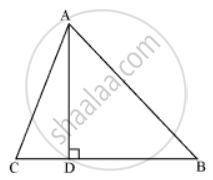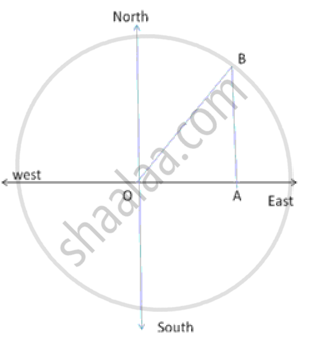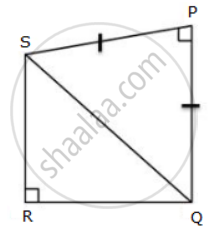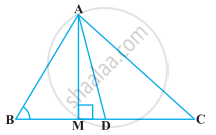Advertisements
Advertisements
प्रश्न
The perpendicular AD on the base BC of a ∆ABC intersects BC at D so that DB = 3 CD. Prove that `2"AB"^2 = 2"AC"^2 + "BC"^2`
उत्तर १
We have

DB = 3CD
BC = BD + DC
The perpendicular AD on the base BC of a ∆ABC intersects BC at D so that DB = 3 CD. Prove that 2AC2 + BC2.
We have,
DB = 3CD
∴ BC = BD + DC
⇒ BC = 3 CD + CD
`⇒ BD = 4 CD ⇒ CD = \frac { 1 }{ 4 } BC`
`∴ CD = \frac { 1 }{ 4 } BC and BD = 3CD = \frac { 1 }{ 4 } BC ….(i)`
Since ∆ABD is a right triangle right-angled at D.
`∴ AB^2 = AD^2 + BD^2 ….(ii)`
Similarly, ∆ACD is a right triangle right angled at D.
`∴ AC^2 = AD^2 + CD^2 ….(iii)`
Subtracting equation (iii) from equation (ii) we get
`AB^2 – AC^2 = BD^2 – CD^2`
`⇒ AB^2 – AC^2 = ( \frac{3}{4}BC)^{2}-( \frac{1}{4}BC)^{2}[`
`⇒ AB^2 – AC^2 = \frac { 9 }{ 16 } BC^2 – \frac { 1 }{ 16 } BC^2`
`⇒ AB^2 – AC^2 = \frac { 1 }{ 2 } BC^2`
`⇒ 2(AB^2 – AC^2 ) = BC^2`
`⇒ 2AB^2 = 2AC^2 + BC^2`
उत्तर २

In ΔACD
AC2 = AD2 + DC2
AD2 = AC2 - DC2 ...(1)
In ΔABD
AB2 = AD2 + DB2
AD2 = AB2 - DB2 ...(2)
From equation (1) and (2)
Therefore AC2 - DC2 = AB2 - DB2
since given that 3DC = DB
DC = `"BC"/(4) and "DB" = (3"BC")/(4)`
`"AC"^2 - ("BC"/4)^2 = "AB"^2 - ((3"BC")/4)^2`
`"AC"^2 - "Bc"^2/(16) = "AB"^2 - (9"BC"^2)/(16)`
16AC2 - BC2 = 16AB2 - 9BC2
⇒ 16AB2 - 16AC2 = 8BC2
⇒ 2AB2 = 2AC2 + BC2.
APPEARS IN
संबंधित प्रश्न
In triangle ABC, ∠C=90°. Let BC= a, CA= b, AB= c and let 'p' be the length of the perpendicular from 'C' on AB, prove that:
1. cp = ab
2. `1/p^2=1/a^2+1/b^2`
In figure, ∠B of ∆ABC is an acute angle and AD ⊥ BC, prove that AC2 = AB2 + BC2 – 2BC × BD
Prove that the sum of the squares of the sides of a rhombus is equal to the sum of the squares of its diagonals
Find the perimeter of the rectangle whose length is 40 cm and a diagonal is 41 cm.
Walls of two buildings on either side of a street are parallel to each other. A ladder 5.8 m long is placed on the street such that its top just reaches the window of a building at the height of 4 m. On turning the ladder over to the other side of the street, its top touches the window of the other building at a height 4.2 m. Find the width of the street.
Find the length of the hypotenuse of a right angled triangle if remaining sides are 9 cm and 12 cm.
In an isosceles triangle, length of the congruent sides is 13 cm and its base is 10 cm. Find the distance between the vertex opposite the base and the centroid.
In triangle ABC, AB = AC = x, BC = 10 cm and the area of the triangle is 60 cm2.
Find x.
Prove that in a right angle triangle, the square of the hypotenuse is equal to the sum of squares of the other two sides.
The sides of the triangle are given below. Find out which one is the right-angled triangle?
11, 12, 15
A man goes 10 m due east and then 24 m due north. Find the distance from the straight point.
In a triangle ABC right angled at C, P and Q are points of sides CA and CB respectively, which divide these sides the ratio 2 : 1.
Prove that: 9AQ2 = 9AC2 + 4BC2
In the given figure. PQ = PS, P =R = 90°. RS = 20 cm and QR = 21 cm. Find the length of PQ correct to two decimal places.
In a square PQRS of side 5 cm, A, B, C and D are points on sides PQ, QR, RS and SP respectively such as PA = PD = RB = RC = 2 cm. Prove that ABCD is a rectangle. Also, find the area and perimeter of the rectangle.
For going to a city B from city A, there is a route via city C such that AC ⊥ CB, AC = 2x km and CB = 2(x + 7) km. It is proposed to construct a 26 km highway which directly connects the two cities A and B. Find how much distance will be saved in reaching city B from city A after the construction of the highway.
In the given figure, AD is a median of a triangle ABC and AM ⊥ BC. Prove that:

(i) `"AC"^2 = "AD"^2 + "BC"."DM" + (("BC")/2)^2`
(ii) `"AB"^2 = "AD"^2 - "BC"."DM" + (("BC")/2)^2`
(iii) `"AC"^2 + "AB"^2 = 2"AD"^2 + 1/2"BC"^2`
Two squares are congruent, if they have same ______.
A right-angled triangle may have all sides equal.
The foot of a ladder is 6 m away from its wall and its top reaches a window 8 m above the ground. Find the length of the ladder.
